Menu
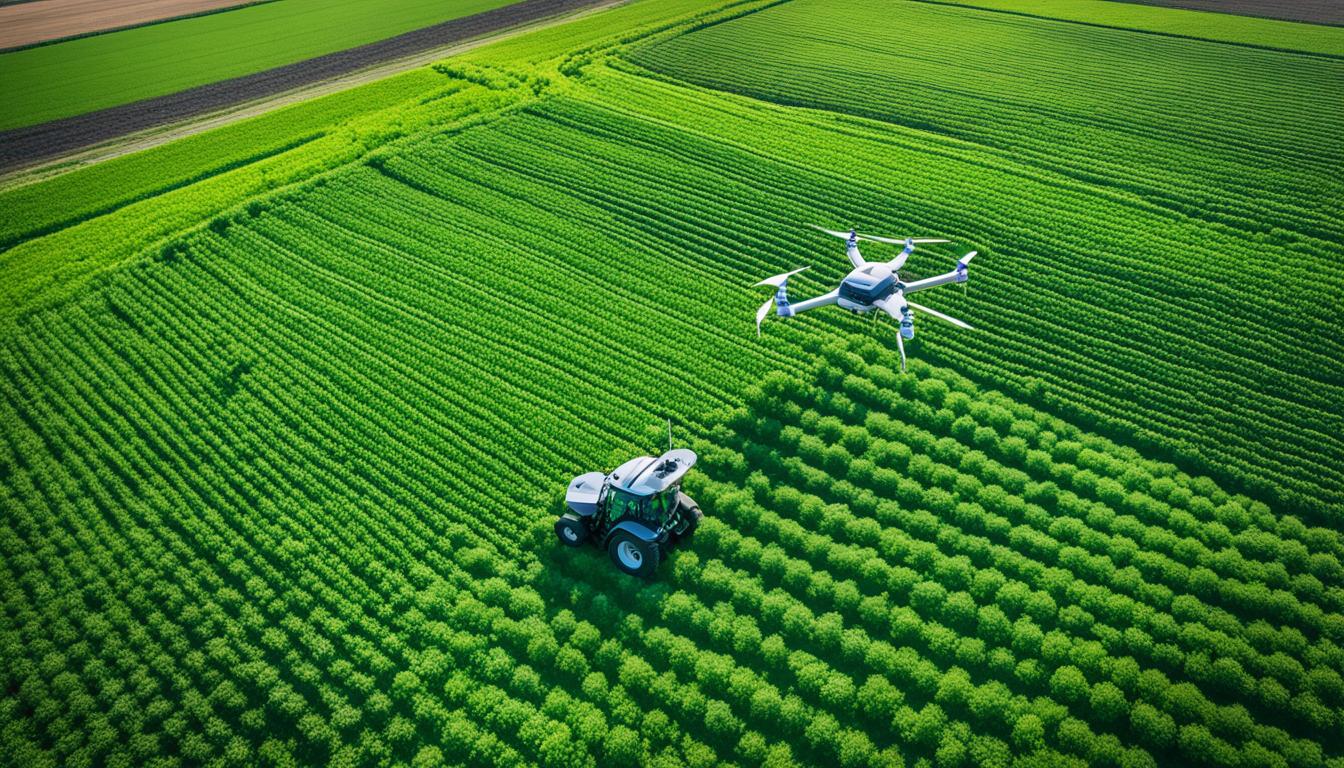
“The future of agriculture is not millions of small farmers with a couple of acres of land each. The future of agriculture is data-driven farming.” – Bill Gates
Data-driven farming is changing the game in agriculture. It lets farmers use data to make smart choices. These choices help the farm grow better and protect the environment. This is all thanks to data analytics, IoT, and tools for precise farming.
Now, farmers can check their progress in real-time and even predict future challenges. Data farming doesn’t just make farms more productive. It also helps save money and boosts rural areas’ economies. It happens by using resources better and smarter.
Agriculture has changed a lot, moving from the old ways to high-tech, data-driven methods. Innovations have changed how we grow and collect crops. These changes are at the heart of farming’s new chapter.
These changes started with smart farming. It’s about using new technologies like agricultural drones, robots, and sensors to help grow food better. Using these tools means we can produce more food. In fact, crop productivity has increased by 25% thanks to IoT sensors.
Now, technology not only helps make more food but also makes food safer and better trusted. Adding product codes increased people’s confidence in food by 30%. Sharing information on crop yields and prices has also cut waste by 20%, making us more efficient.
Technology helps farmers make better choices and use resources smarter. Monitoring machines in real-time has cut downtime by 30%. This saves money and time. Also, using AI to spot diseases early prevents a lot of crop damage. It stops 40% of the harm, showing tech’s big role in smart farming.
Sharing farming data is key too, like data on pests across several farms. This info helps solve problems more together. Using tech like precision tools and managing farms with data is making smart farming a reality.
Next, let’s see how various technologies in farming have made a difference:
| Technology | Impact | Percentage Improvement |
|---|---|---|
| IoT Sensors | Increased Crop Productivity | 25% |
| Product Identification Codes | Rise in Consumer Trust | 30% |
| Data Centralisation | Reduction in Agricultural Waste | 20% |
| AI-Based Attendance Systems | Improved Labour Productivity | 15% |
| Real-Time Monitoring | Reduced Downtime | 30% |
| AI Surveillance Systems | Prevented Crop Damage | 40% |
In conclusion, moving towards data-focused farming is making our farms better. It’s helping us grow more, in a safer and smarter way. By using these new ways, we’re more ready than ever to face the future of food production.
Precision agriculture is growing fast thanks to new technologies. These tools help farmers meet the food needs of our increasing population. They make it possible to use resources effectively, grow more food, and take care of the Earth.
Satellite imagery and drones are transforming how we see farms from above. They capture detailed images that help farmers study crops and fields closely. Drones with RTK tech, for example, make mapping quick and accurate. This cutting-edge analysis tracks crop health, soil quality, and differences across fields.
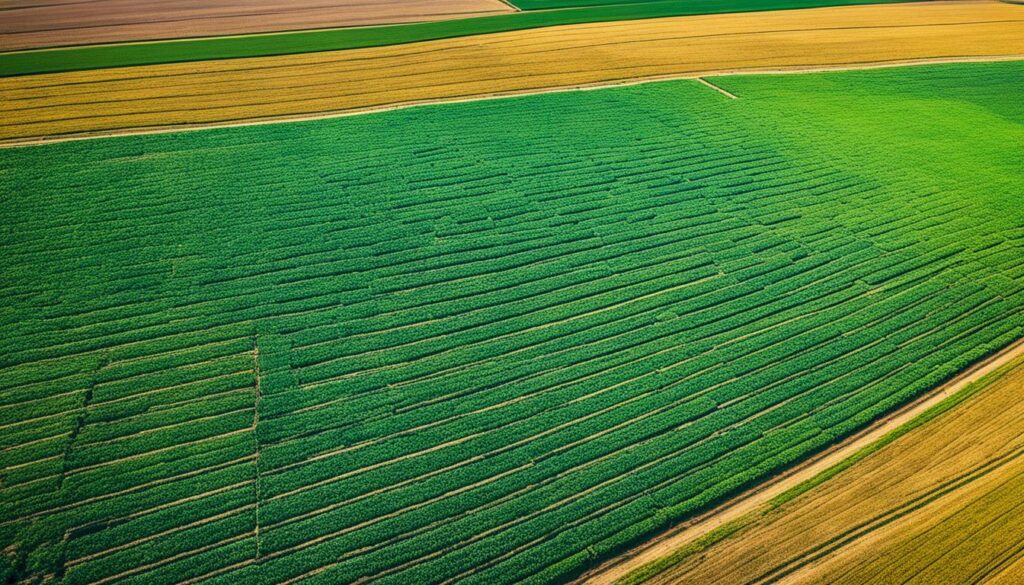
The use of IoT in farming involves many smart devices and sensors. These include tools for measuring soil and scanning crops. They collect a lot of data fast, such as moisture levels and nutrient content. This information is used by smart irrigation systems to water crops just right, keeping them healthy.
Big data is changing the game in modern farming by handling massive amounts of info. It takes data from sensors and satellites to provide key insights. These insights help adjust farming techniques for better results. For instance, they help with scouting, testing soil, and deciding on the right amount of nutrients to apply. This smart use of data helps farmers do more with less, boosting crops and saving resources.
Data-driven farming has changed agriculture with technology and real-time data. It has boosted the farm’s results and its green efforts. Farming has become smarter, tackling old problems and gaining bigger yields. There’s less waste and the land benefits, too.
Data-driven farming means increased agricultural efficiency. Tools like drones and info systems detail the best way to work the land. These insights help farmers choose the best times to plant or water, leading to more crops.
Using the right amount of water, fertilisers, and pesticides matters a lot. Data insights ensure smart use of these resources. This accuracy cuts waste and saves money. Systems manage resources well, making farms greener.
Saving our planet is key. Data-driven farming does this by using inputs carefully. This cuts pollution and keeps the soil healthy. It’s a win for nature and for the farms, making farming good for everybody.
Smart farming is not just about more food. It’s building a farming future that’s strong and green. This new way is essential for the future, keeping food coming without harming the planet.
Monitoring crops is key to helping them grow well and produce a lot. By using new tools and methods, farmers can see exactly how their crops are doing. This way, they can take action early, which makes their crops better and more plentiful.
Things like satellites and drones are changing how we farm. They take very detailed pictures that show us lots about the crops. By using special tools and computer smarts, farmers can spot when crops are in trouble. Then, they can fix things quickly, using less of everything.
Sensors in the fields now can tell us about the soil and plant health right any time. This helps keep crops from getting sick. Plus, smart devices make sure this information is always correct, helping farmers use water and fertiliser well.

Looking at all the data from sensors and high-tech tools really helps farmers. It lets them make decisions that keep their crops healthy. With the help of clever computers, they can find the best ways to care for their plants. This makes farming smarter and more successful.
Putting all these new technologies together shows how farming is becoming very precise. It makes farms produce more without hurting the planet. As we get better at using these cool tools, farming gets a lot brighter and more efficient.
Good data management in farming is key to making the most of data in agriculture. By setting up strong ways to collect and use data, it becomes easy for everyone involved in farming to access and apply it. It’s important to tailor these systems to fit the specific needs and tech know-how of local farmers.
By using precise data, farming becomes less wasteful and costly. It keeps a close eye on soil and crops to wisely use resources. This not only boosts the amount and quality of crops but also cuts down on harmful chemicals, making farming more eco-friendly.
A smart digital farming data strategy brings together different data like weather, crop health, and soil. This lets us look at the detail through predictive analytics, with tools that guess crop yields quite accurately. Gathering data in real time also helps keep an eye on soil and crops as they change.
Watching data in real time is critical for a successful data-focused farm. In places like India, turning to tech has really upped the game in farming. Using big data, farmers can spot problems early and fix them fast, which makes their work more productive and efficient.
Predictive analysis in farming changes the game by offering vital information. Farmers can look ahead, spotting upcoming difficulties. This helps them tweak their methods, making things run better and produce more.
The ability to predict weather accurately is very important. It lets farmers get ready for bad weather which could harm their crops. They use info about things like temperature, humidity, and rainfall to see how well crops might do.
This means they can adjust their farming to protect the crops better. So, they waste less and the crops can be of higher quality.
Prediction analytics are also handy for forecasting pests and diseases. This helps them act quickly to stop or lessen the damage. By looking at things like growth stages and past pests, they can choose when to switch crops or use particular ways to manage pests. This protects the crops and helps them produce more.
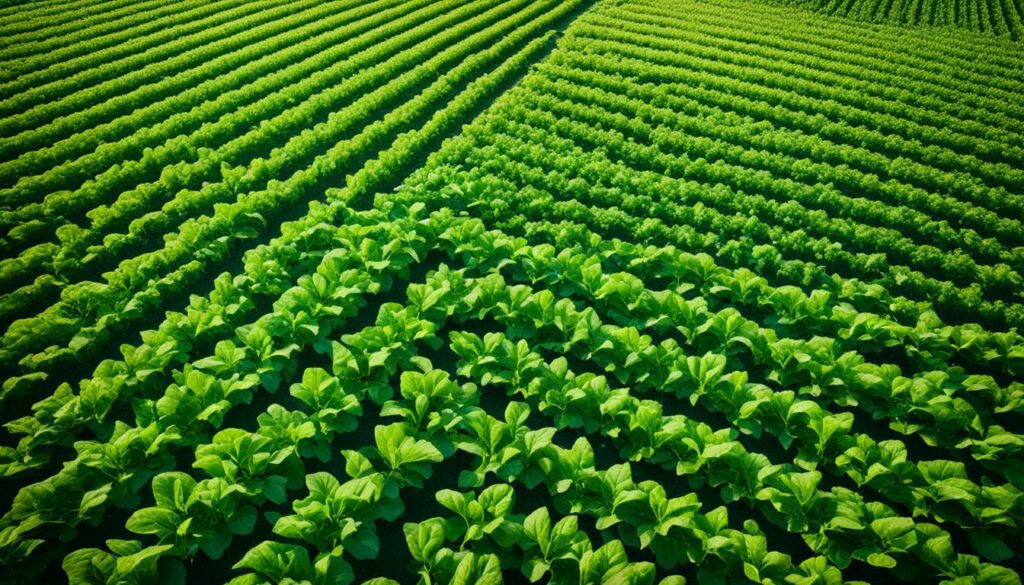
Knowing what people want is key to farming successfully. By forecasting demand, farmers can time their planting and harvesting just right. This also guides them in picking what to grow and how to sell it.
Thanks to forecasts, they can ramp up their profits while staying ahead in the market.
Smart farming uses new tech to change how we farm. It uses AI and machine learning to look at big sets of data. This data helps farmers make better decisions, improving how they use resources and get more work done.
AI and machine learning are making a big impact on agriculture. They look at data about crops, soil, and pests to help farmers. With this help, farmers can decide when it’s best to plant and harvest to avoid bad weather.
Smart farming helps automate farm tasks. This includes using robots and autonomous tractors to plant, harvest, and prune. It also involves using drones to perfectly apply fertilisers and pesticides. This lowers costs and makes farms more efficient.
One key feature of smart farming is data sharing. It lets different systems work together easily. This is important for fighting pests and making sure all farm data is consistent. Everyone involved can make better choices with accurate information.
Smart farming helps farms use resources better and be more eco-friendly. It’s key to meeting future food needs while caring for the planet. This approach is not just about tackling today’s issues, but it’s also about continuous growth through innovation in agriculture.
Data insights are changing farming, offering powerful tools to boost success. They turn complex data into simple, useful actions. This lets farmers grow their crops better, using less and helping the planet. Mobile apps are a new, easy way for all farmers to get and understand important data, even without tech skills.
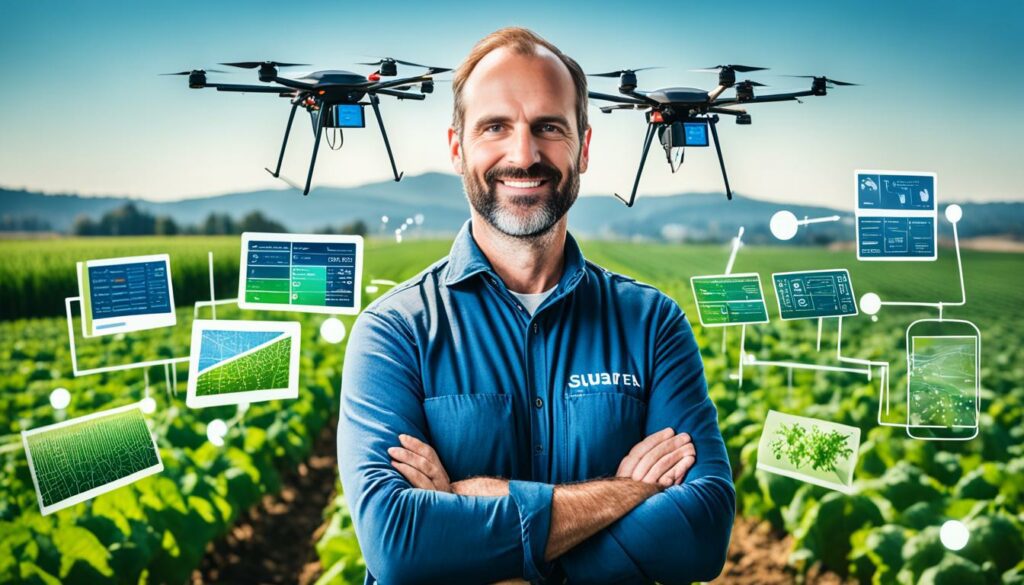
Special mobile apps are now available that make using data easier for farmers. They’re user-friendly, helping all farmers, no matter their tech knowledge. These apps help keep an eye on crops, use resources wisely, and choose the best ways to grow more and waste less.
For example, YaraFX Insight, the N-tester and N-sensor, plus Atfarm, YaraConnect, and FarmCare are great for precision farming. These reduce costs, improve profits, and are good for the Earth. They use less and need fewer hands to work.
Training and community support are vital for embracing new farming technologies. They teach farmers how to use mobile apps and smart tools. This helps everyone, even small or family farms, to do better. They learn to make their farming more effective using new insights.
Yara and others lead in training and teamwork around the world. They bring together digital teams to help with good farming practices and digital tools. Supporting training helps farmers save energy, meet global eco-goals, and grow more food.
Moving to data-driven farming is exciting but tough. We have to solve integration issues to use technology well. Keeping data safe is another big problem.
Getting new tech to work with the old is hard. Farmers might be used to old ways and not ready for this change. GPS, GIS, and sensors help understand the land better. But learning to use them well is a challenge.
Education and support are key to get past these hurdles. Making tools that are easy to use also helps. This way, farmers can use their resources better.
In smart farming, keeping data private is a big deal. Farmers get a lot of data that can help but also worry them. Things like who sees the data and how it’s used are top concerns.
Security is vital to protect this info. Using strong security and following privacy laws is crucial. It’s important to store data safely and transfer it securely. This builds trust among farmers.
| Challenges | Solutions |
|---|---|
| Integration of New Technologies | Continuous education and support initiatives, easy-to-use tools |
| Data Privacy and Security | Implement robust security protocols, encrypted storage, secure data transfer |
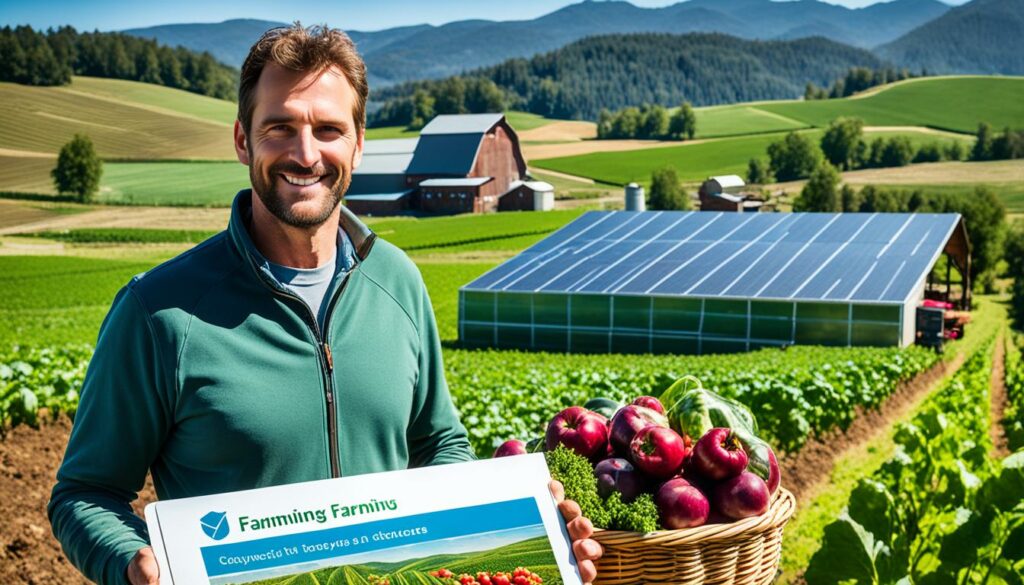
Farming has changed a lot thanks to new data tools. These high-tech tools have boosted farming’s efficiency. For example, many projects around the world have received a lot of money. This shows how much the farming industry is turning to tech.
Using resources wisely is key to making farming more profitable. With millions online and owning mobile devices, farmers can get valuable tips from data. This helps them use water, fertilisers, and pesticides better, saving money and boosting yields.
Digital tech also helps lower food waste levels. It lets farmers and suppliers better track their products. This reduces waste and helps farm profits by making resource use more efficient.
Farms that use data strategies do better in the market. Examples from Kenya and India have helped millions of small farmers. These projects have brought in lots of money. They show how data can make farming more flexible and meet what customers want.
Even with challenges like uneven digital access, data tech offers big chances. Overcoming these hurdles with better data use and teamwork is crucial. It will help farmers stay strong in the market.
| Region | Internet Users | Mobile Phone Owners | Disposable Income Spent on Food |
|---|---|---|---|
| Global | 4.6 billion | 5.2 billion | – |
| Sub-Saharan Africa | Approx. 50% of disposable income | 34%-51% | Approx. 50% |
Using data in farming boosts productivity, profit, and market strength. Investing more in digital tools will keep making a big difference in farming.
Data-driven farming is key to sustainable agriculture. It uses technology to cut down on harm to our environment. This approach helps us use resources wisely and improve how we farm.
Precision farming makes our crops more resilient to climate change. It involves using just the right amount of water, fertilisers, and pesticides. This reduces waste and pollution, keeping our soil and water clean.
Precision farming also means less soil erosion and pollution. It uses data to wisely decide where to put resources. This way, farmers can grow more food using fewer chemicals and water. It’s good for the earth and helps in saving our resources.
Solar-powered systems are another big win for the environment. They lower our use of fossil fuels and fight climate change. Technology that makes farming equipment smarter also helps save energy. This is how we work towards a greener farming future.
Smart irrigation not only saves water but protects our local water supplies. It uses data to water plants exactly when they need it. This makes our farms more efficient and less taxing on the environment.
| Practice | Benefit | Environmental Impact |
|---|---|---|
| Precision Agriculture | Optimised Resource Use | Reduces Inputs, Maximises Yields |
| Sustainable Agriculture | Minimises Runoff and Erosion | Less Chemical Usage |
| Solar-Powered Irrigation | Reduces Fossil Fuel Reliance | Lower Greenhouse Gas Emissions |
| Smart Irrigation | Reduces Water Waste | Preserves Local Water Resources |
Precision agriculture is all about balance. It’s not just about more crops. It’s about creating a future where our farming doesn’t harm the planet. By focusing on both productivity and the environment, we secure a healthy future for farming.
The future of farming with data is exciting. It is bringing new technologies and better global teamwork. This will improve how we farm, making it more efficient and kind to our planet. The farming world is about to change a lot.
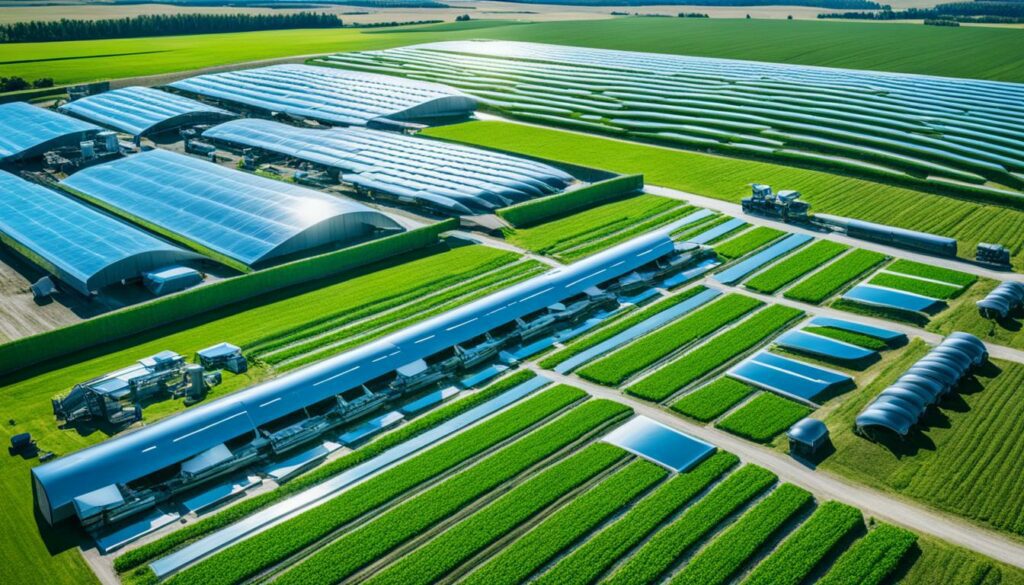
New sensors and tech are changing farming. Things like seeing plants with your computer or talking to machines. Drones, for example, can take super clear pictures from the sky. These can help us see how healthy plants are and where we can use the land better.
Using past information, farmers know better when to plant and harvest. This makes them grow more food with less waste. As a result, farming will become smarter and better for everyone.
Working together worldwide is also key. Sharing what works helps all farmers do better. There are tech tools that mix information from different places. This way, farmers get helpful, real-time insights. It lets them use their resources better, which is good for the planet.
But not everyone has the same access to new tech. Smaller farms often don’t have good internet services. This is a big problem. Everyone should have the chance to use new farming tech. This way, all farmers can improve together, leaving no one behind.
“The future of farming lies in harnessing the power of data and technology to drive efficiency, sustainability, and global prosperity.”
Embracing new farming tech and working together gives us hope. We’ll see big changes in how we farm. By using new tech wisely and working as a team, we can make farming better and kinder to our planet.
The mix of tech and farming can change how farms work. This change helps farmers do things more precisely, saving time and being kinder to the planet. Digital tools don’t just help farms. They also boost the local economy and give small farmers a leg up. By using smart data and tech, we can make the country life better and help small towns grow.
Digital farming boosts small towns by making their businesses stronger. New tech lets farmers make better choices, improving how they use the land and showing clear steps in food making. This change revamps how business is done in the countryside. It helps local companies do better. Plus, things like the Precision Farming Results Pack and projects funded by the EU push for more digital upgrades. These moves help rural areas grow economically.
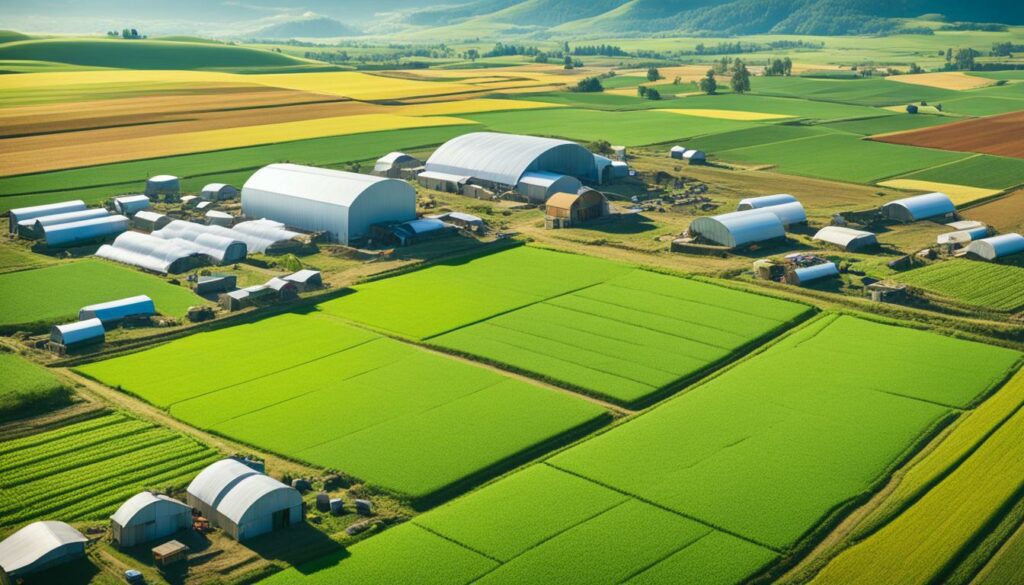
It’s important to help small farms grow in the countryside. The European Innovation Partnership for Agriculture is one way to do this. This partnership helps especially the small farms, which are a big part of food production worldwide. It gives them access to high-tech tools. By doing this, it boosts how much they can do and helps them be kind to the earth. Farming smarter means they make more money. This supports the whole community around them. To make this work, there are programs and projects helping small farmers learn how to use the new tools.
Rural community development is closely linked with helping small farmers succeed. The good part is, digital farming is already making a difference, with more to come. It’s all about keeping up the innovation and investment in farming. This will make the countryside better and farming more sustainable.
Data-driven farming is changing agriculture in a big way. It uses new tech like predictive analytics and real-time monitoring. This move has made farming more efficient, sustainable, and productive. Now, we can use resources better, reduce waste, and help the environment.
Sustainable agriculture is essential for tomorrow. It looks to boost productivity without using up resources. Farming relies on five types of ‘capital,’ like nature and people. Data-driven tools help farm smarter by using information and technology wisely. This improves how we use these resources.
Precision farming gathers lots of data on things like weather and soil. This knowledge helps us farm in ways that waste less and grow more. It also helps to spot threats, like pests, early. This means we can protect crops better. But, we must handle data issues and make all tools work together smoothly.
The future of precision farming looks bright. More tech advancements, like the Internet of Things and robots, will boost farming. These changes will bring more efficiency and productivity to farms. They offer a path to a strong, green future for farming. This move benefits both farmers and their communities worldwide. It paves the way for a successful future in farming, driven by data.
Data-driven farming, also known as precision agriculture, uses detailed data and high-tech tools. It aims to make agricultural activities more efficient and eco-friendly. It helps make better decisions to improve crop yield and sustainability.
Farmers gain several benefits from precision agriculture. It helps them use resources better, cut down on waste, and boost productivity. Tools like satellite images, IoT sensors, and big data let farmers monitor their crops closely and manage resources with precision.
Precision agriculture uses many high-tech solutions. This includes satellite images, drones, and IoT sensors for gathering real-time data. Big data analytics then offer farmers detailed insights. All this helps in the accurate monitoring and management of crops.
Crop monitoring involves technologies like remote sensing and on-the-ground sensors. It uses data analytics to track how crops are performing. As a result, farmers can take early action to ensure their crops grow well and are productive.
Good data management in farming means having solid systems for collecting and handling data. Storing data well and making sure people can actually use it is key. Using systems that are easy for farmers to understand and compatible with their needs is important.
Predictive analysis is useful because it helps farmers see future challenges. It can predict weather, disease outbreaks, and even what crops the market will need. Armed with this knowledge, farmers can plan ahead to avoid problems and make the most of their operations.
Smart farming is about using AI, machine learning, and automation to improve farming. By analysing big data, these technologies help in making very precise decisions. They also help in automating tasks, which makes farming more accurate and less costly.
Mobile apps simplify access to complex data for farmers. They make it easy for farmers to understand and act on important information, even if they’re not tech-savvy. These apps and related training initiatives help farmers step into the era of smart agriculture.
Adapting new tech and keeping data safe are big challenges. The key to solving them is working together on educating and supporting users, and creating tech that’s easy and safe to use. This needs to ensure farmers have what they need to keep their data secure and their operations running well.
Data-driven farming boosts the economy by making farms more productive and profitable. It cuts costs by using resources wisely and saves money. Farms can also produce higher-quality goods which can be more competitive in the market.
Data-driven farming helps the environment by using water, fertilisers, and pesticides more wisely. This way, it reduces waste and protects natural resources. It also helps in keeping the ecosystem in balance.
In the future, data-driven farming will see more advanced sensors, AI, and machine learning. This will lead to farming that’s more efficient and accurate. Sharing knowledge and working together internationally will drive these innovations forward.
Data-driven farming is good for rural areas, making local economies stronger and helping small farms. It gives farmers access to high-tech tools and insights that boost their income. This, plus education and community programs, helps rural areas grow.